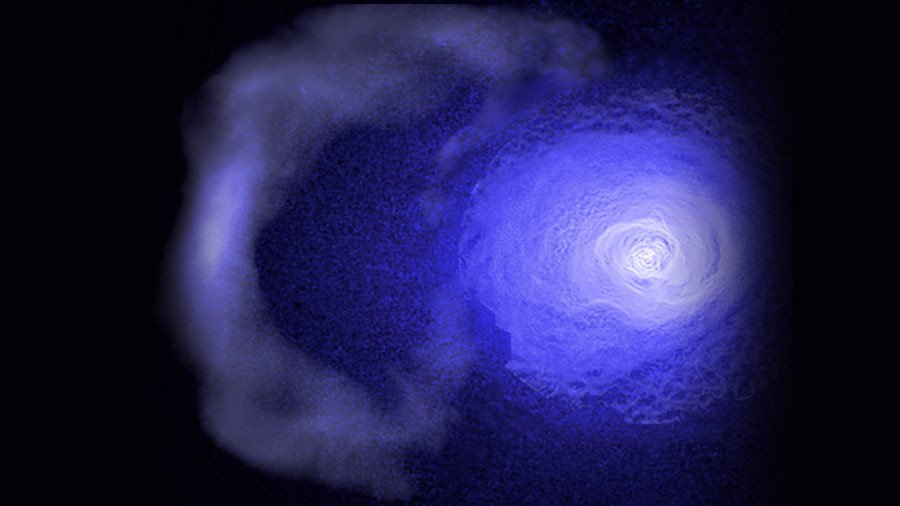The really big chill: Ancient cold front sweeps ‘relentlessly’ across galaxy cluster (VIDEO)

NASA has detected an enormous and “relentless” cold front sweeping across one of the largest objects in the universe. The find calls into question our understanding of cosmic weather.
The “gigantic” cold front, analyzed by NASA’s Chandra Observatory, is located in the Perseus galaxy cluster and extends for about two million light years. It consists of a relatively dense band of gas with a “cool” temperature of about 30 million degrees moving through lower density hot gas with a temperature of about 80 million degrees
The cosmic cold front formed about five billion years ago, making it older than our Solar System. It has been traveling at speeds of about 300,000 miles per hour ever since, leading scientists to predict that it would be looking a little hazy around the edges by now.
A gigantic cosmic cold front in the Perseus galaxy cluster spans ~2 million light years! The front has been hurtling through the cluster at roughly 300,000 mph for more than 5 billion years — that's longer than the existence of our Solar System! #News: https://t.co/FJ4X4YbiP3pic.twitter.com/iREN07uJtm
— Chandra Observatory (@chandraxray) April 3, 2018
X-ray imaging, however, reveals a sharp, crisp picture, leading researchers to suggest that magnetic fields may be surrounding and preserving the front.
“The size, age, speed and sharpness of this cold front are remarkable,” said Stephen Walker of NASA’s Goddard Space Flight Center in Greenbelt, Maryland, who led the study. “Everything about this cosmic weather system is extreme.”
Galaxy clusters are the largest objects in the Universe that are held together by gravity. As the cold front travels through a cluster, it passes through a harsh environment of sound waves and turbulence, caused by outbursts from the supermassive black hole at the center of Perseus.
This chaotic activity would be expected to impact the cold front, however this has not been the case. “Somehow, in the face of all this bombardment, the cold front edge has survived intact,” said co-author John ZuHone of the Harvard-Smithsonian Center for Astrophysics in Cambridge, Massachusetts. “Rather than being eroded or smoothed out, it has actually instead split into two distinct sharp edges!”
Scientists say they are not entirely sure of the reasoning behind this resilience but their computer simulations are pointing towards magnetic fields. “It seems that magnetic fields have draped themselves over the cold front, acting almost like a shield against the barrage of forces from the rest of the cluster,” Jeremy Sanders, a co-author from the University of Cambridge in the United Kingdom, explained.
Researchers tested the effects of three different magnetic field strengths finding that no split was seen in the cold front with the strongest magnetic field but the simulation with an intermediate strength magnetic field reproduced the split cold front. In the case of the weakest magnetic field the cold front became blurred.
The magnetic field along the cold front is equivalent to about one millionth of the strength of a typical refrigerator magnet, and is about ten times higher than in parts of the cluster away from the cold front.
Perseus is the same cluster where last year NASA discovered a giant wave about twice the width of the Milky Way galaxy.
READ MORE: 72 baffling bright & fast explosions spotted in space
Like this story? Share it with a friend!















